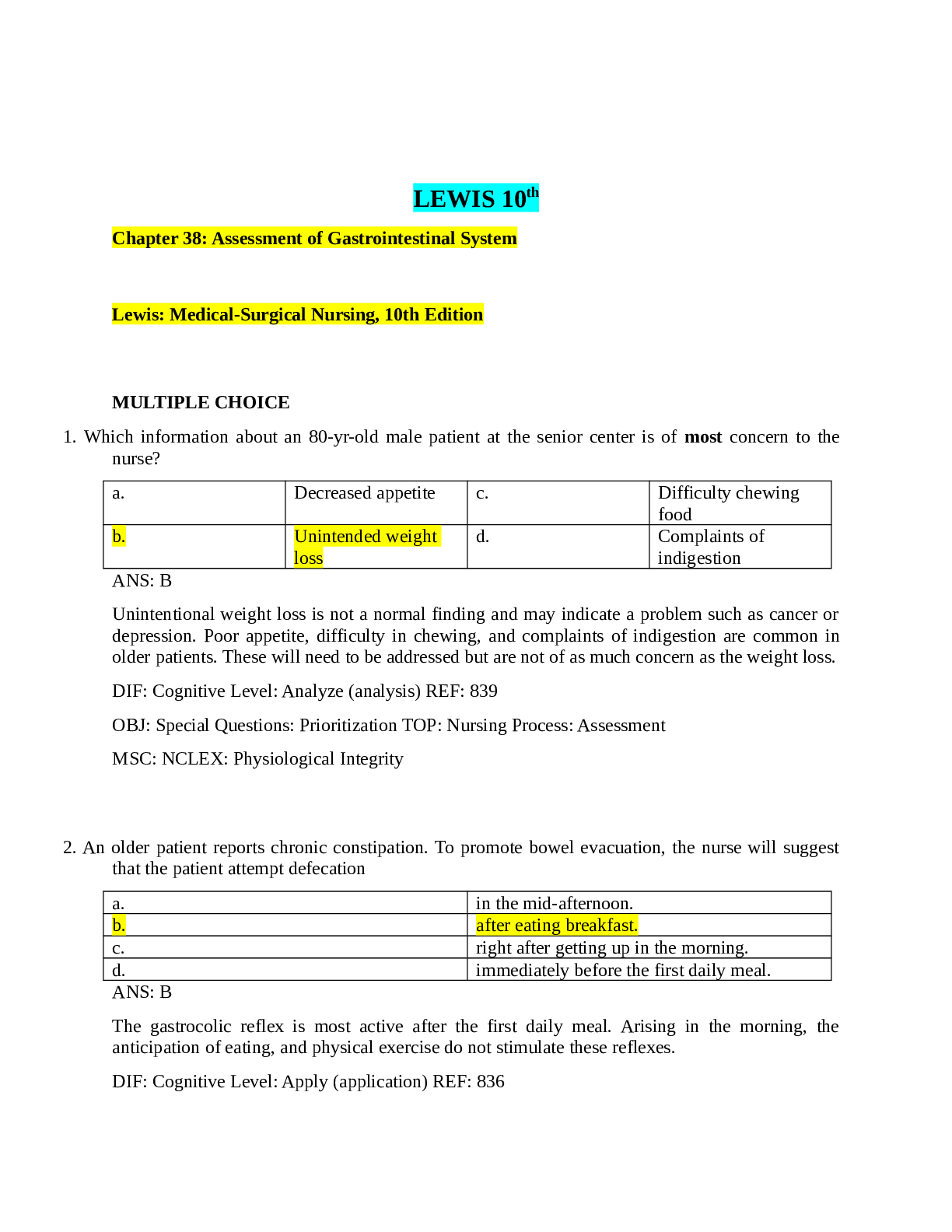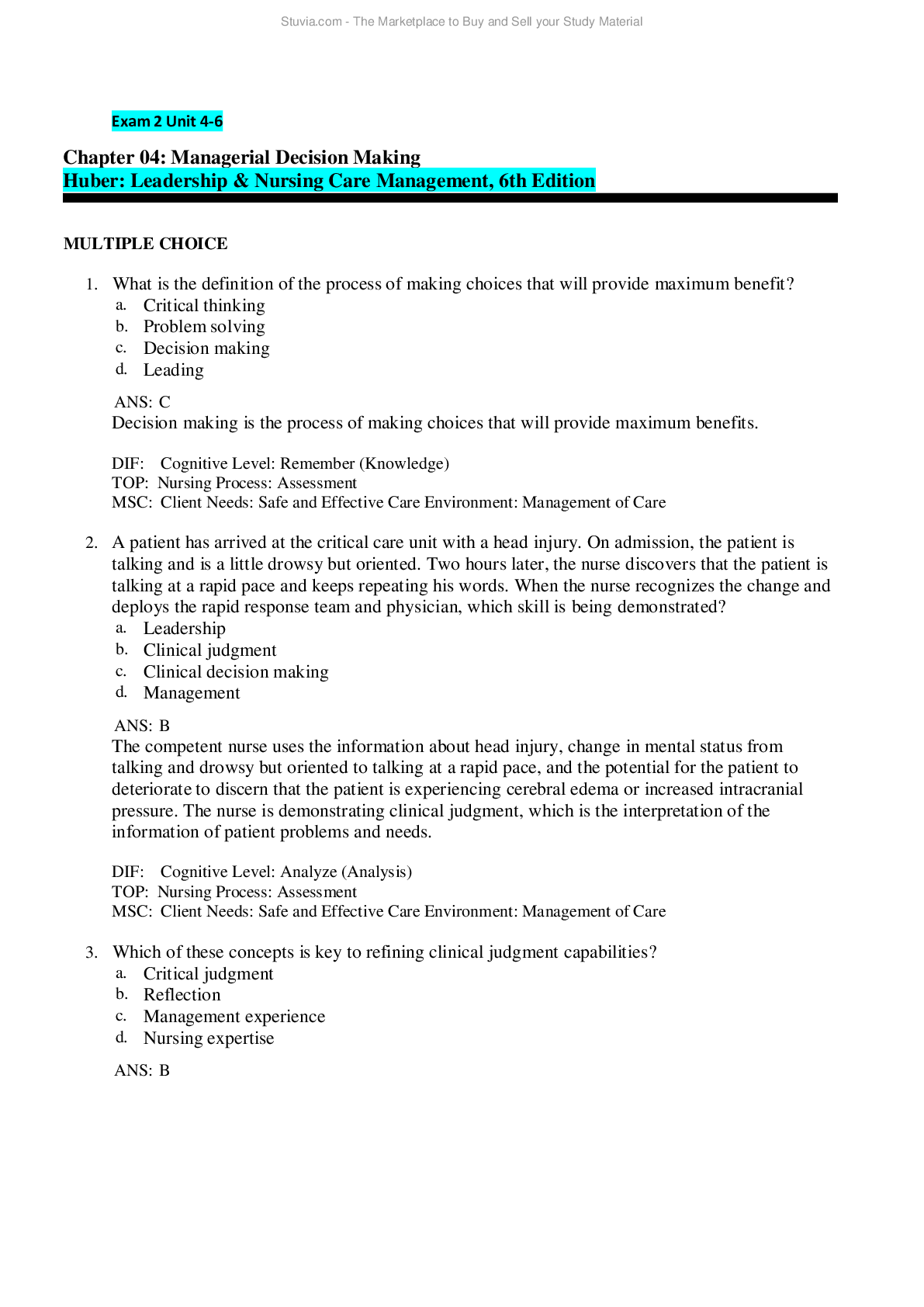*NURSING > TEST BANKS > Essentials of Nursing Leadership & Management, 6th Edition (All)
Essentials of Nursing Leadership & Management, 6th Edition
Document Content and Description Below
Nurses study leadership to learn how to work well with other people. We work with an extraordinary variety of people: technicians, aides, unit managers, housekeepers, patients, patients’ families... , physicians, respiratory therapists, physical therapists, social workers, psychologists, and more. In this chapter, the most prominent leadership theories are introduced. Then, the characteristics and behaviors that can make you, a new nurse, an effective leader and follower are discussed. Leadership Are You Ready to Be a Leader? You may be thinking, “I’m just beginning my career in nursing. How can I be expected to be a leader now?” This is an important question. You will need time to refine your clinical skills and learn how to function in a new environment. But you can begin to assume some leadership functions right away within your new nursing roles. In fact, leadership should be seen as a dimension of nursing practice (Scott & Miles, 2013). Consider the following example: Billie Thomas was a new staff nurse at Green Valley Nursing Care Center. After orientation, she was assigned to a rehabilitation unit with high admission and discharge rates. Billie noticed that admissions and discharges were assigned rather haphazardly. Anyone who was “free” at the moment was directed to handle them. Sometimes, unlicensed assistant personnel were directed to admit or discharge residents. Billie believed that this was inappropriate because they are not prepared to do assessments and they had no preparation for discharge planning. Billie had an idea how discharge planning could be improved but was not sure that she should bring it up because she was so new. “Maybe they’ve already thought of this,” she said to a former classmate. They began to talk about what they had learned in their leadership course before graduation. “I just keep hearing our instructor saying, ‘There’s only one manager, but anyone can be a leader.’ ” “If you want to be a leader, you have to act on your idea. Why don’t you talk with your nurse manager?” her friend asked. “Maybe I will,” Billie replied. Billie decided to speak with her nurse manager, an experienced rehabilitation nurse who seemed not 3663_Chapter 1_0003-0016.indd 3 663_Chapter 1_0003-0016.indd 3 9/15/2014 4:36:35 PM /15/2014 4:36:35 PM Process Cyan rocess CyanProcess Magenta rocess MagentaProcess Yellow rocess YellowProcess Black rocess Black 4 unit 1 ■ Professional Considerations only approachable but also open to new ideas. “I have been so busy getting our new electronic health record system on line before the surveyors come that I wasn’t paying attention to that,” the nurse manager told her. “I’m glad you brought it to my attention.” Billie’s nurse manager raised the issue at the next executive meeting, giving credit to Billie for having brought it to her attention. The other nurse managers had the same response. “We were so focused on the new electronic health record system that we overlooked that. We need to take care of this situation as soon as possible. Billie Thomas has leadership potential.” Leadership Defined Successful nurse leaders are those who engage others to work together effectively in pursuit of a shared goal. Examples of shared goals in nursing would be providing excellent care, reducing infection rates, designing cost-saving procedures, or challenging the ethics of a new policy. Leadership is a much broader concept than is management. Although managers need to be leaders, management itself is focused specifically on achievement of organizational goals. Leadership, on the other hand: . . . occurs whenever one person attempts to influence the behavior of an individual or group—up, down, or sideways in the organization—regardless of the reason. It may be for personal goals or for the goals of others, and these goals may or may not be congruent with organizational goals. Leadership is influence (Hersey & Campbell, 2004, p. 12). In order to lead, one must develop three important competencies: (1) diagnose: ability to understand the situation you want to influence, (2) adapt: make changes that will close the gap between the current situation and what you are hoping to achieve, and (3) communicate. No matter how much you diagnose or adapt, if you cannot communicate effectively, you will probably not meet your goal (Hersey & Campbell, 2004). What Makes a Person a Leader? Leadership Theories There are many different ideas about how a person becomes a good leader. Despite years of research on this subject, no one idea has emerged as the clear winner. The reason for this may be that different qualities and behaviors are most important in different situations. In nursing, for example, some situations require quick thinking and fast action. Others require time to figure out the best solution to a complicated problem. Different leadership qualities and behaviors are needed in these two instances. The result is that there is not yet a single best answer to the question, “What makes a person a leader?” Consider some of the best-known leadership theories and the many qualities and behaviors that have been identified as those of the effective nurse leader (Pavitt, 1999; Tappen, 2001): Trait Theories At one time or another, you have probably heard someone say, “She’s a born leader.” Many believe that some people are natural leaders, while others are not. It is true that leadership may come more easily to some than to others, but everyone can be a leader, given the necessary knowledge and skill. An important 5-year study of 90 outstanding leaders by Warren Bennis published in 1984 identified four common traits. These traits hold true today: 1. Management of attention. These leaders communicated a sense of goal direction that attracted followers. 2. Management of meaning. These leaders created and communicated meaning and purpose. 3. Management of trust. These leaders demonstrated reliability and consistency. 4. Management of self. These leaders knew themselves well and worked within their strengths and weaknesses (Bennis, 1984). Behavioral Theories The behavioral theories focus on what the leader does. One of the most influential behavioral theories is concerned with leadership style (White & Lippitt, 1960) (Table 1-1). The three styles are: 1. Autocratic leadership (also called directive, controlling, or authoritarian). The autocratic leader gives orders and makes decisions for the group. For example, when a decision needs to be made, an autocratic leader says, “I’ve decided that this is the way we’re going to solve our 3663_Chapter 1_0003-0016.indd 4 663_Chapter 1_0003-0016.indd 4 9/15/2014 4:36:37 PM /15/2014 4:36:37 PM Process Cyan rocess CyanProcess Magenta rocess MagentaProcess Yellow rocess YellowProcess Black rocess Black chapter 1 ■ Leadership and Followership 5 problem.” Although this is an efficient way to run things, it squelches creativity and may reduce team member motivation. 2. Democratic leadership (also called participative). Democratic leaders share leadership. Important plans and decisions are made with the team (Chrispeels, 2004). Although this appears to be a less efficient way to run things, it is more flexible and usually increases motivation and creativity. In fact, involving team members, giving them “permission to think, speak and act” brings out the best in them and makes them more productive, not less (Wiseman & McKeown, 2010, p. 3). Decisions may take longer to make, but once made everyone supports them (Buchanan, 2011). 3. Laissez-faire leadership (also called permissive or nondirective). The laissez-faire (“let someone do”) leader does very little planning or decision making and fails to encourage others to do it. It is really a lack of leadership. For example, when a decision needs to be made, a laissezfaire leader may postpone making the decision or never make the decision at all. In most instances, the laissez-faire leader leaves people feeling confused and frustrated because there is no goal, no guidance, and no direction. Some mature, self-motivated individuals thrive under laissez-faire leadership because they need little direction. Most people, however, flounder under this kind of leadership. Pavitt summed up the differences among these three styles: a democratic leader tries to move the group toward its goals; an autocratic leader tries to move the group toward the leader’s goals; and a laissez-faire leader makes no attempt to move the group (1999, pp. 330ff ). Task Versus Relationship Another important distinction is between a task focus and a relationship focus (Blake, Mouton, & Tapper, 1981). Some nurses emphasize the tasks (e.g., administering medication, completing patient records) and fail to recognize that interpersonal relationships (e.g., attitude of physicians toward nursing staff, treatment of housekeeping staff by nurses) affect the morale and productivity of employees. Others focus on the interpersonal aspects and ignore the quality of the job being done as long as people get along with each other. The most effective leader is able to balance the two, attending to both the task and the relationship aspects of working together. Motivation Theories The concept of motivation seems simple: we will act to get what we want but avoid whatever we don’t want to do. However, motivation is still surrounded in mystery. The study of motivation as a focus of leadership began in the 1920s with the historic Hawthorne studies. Several experiments were conducted to see if increasing light and, later, improving other working conditions would increase the productivity of workers in the Hawthorne, Illinois, electrical plant. This proved to be true, but then something curious happened: when the improvements were taken away, the workers continued to show increased productivity. The researchers concluded that the explanation was found not in the conditions of the experiments but in the attention given to the workers by the experimenters. table 1-1 Comparison of Autocratic, Democratic, and Laissez-Faire Leadership Styles Autocratic Democratic Laissez-Faire Amount of freedom Little freedom Moderate freedom Much freedom Amount of control High control Moderate control Little control Decision making By the leader Leader and group together By the group or by no one Leader activity level High High Minimal Assumption of responsibility Leader Shared Abdicated Output of the group High quantity, good quality Creative, high quality Variable, may be poor quality Efficiency Very efficient Less efficient than autocratic style Inefficient Source: Adapted from White, R.K., & Lippitt, R. (1960). Autocracy and democracy: An experimental inquiry. New York: Harper & Row. 3663_Chapter 1_0003-0016.indd 5 663_Chapter 1_0003-0016.indd 5 9/15/2014 4:36:37 PM /15/2014 4:36:37 PM Process Cyan rocess CyanProcess Magenta rocess MagentaProcess Yellow rocess YellowProcess Black rocess Black 6 unit 1 ■ Professional Considerations Frederick Herzberg and David McClelland also studied factors that motivated workers in the workplace. Their findings are similar to the elements in Maslow’s Hierarchy of Needs. Table 1-2 summarizes these three historical motivation theories that continue to be used by leaders today (Herzberg, 1966; Herzberg, Mausner, & Snyderman, 1959; Maslow, 1970; McClelland, 1961). Emotional Intelligence The relationship aspects of leadership are also the focus of the work on emotional intelligence and leadership (Goleman, Boyatzes, & McKee, 2002). From the perspective of emotional intelligence, what distinguishes ordinary leaders from leadership “stars” is that the “stars” are consciously addressing the effect of people’s feelings on the team’s emotional reality. How is this done? First, the emotionally intelligent leader recognizes and understands his or her own emotions. When a crisis occurs, he or she is able to manage them, channel them, stay calm and clearheaded, and suspend judgment until all the facts are in (Baggett & Baggett, 2005). Second, the emotionally intelligent leader welcomes constructive criticism, asks for help when needed, can juggle multiple demands without losing focus, and can turn problems into opportunities. Third, the em [Show More]
Last updated: 2 years ago
Preview 1 out of 269 pages

Buy this document to get the full access instantly
Instant Download Access after purchase
Buy NowInstant download
We Accept:

Reviews( 0 )
$11.00
Can't find what you want? Try our AI powered Search
Document information
Connected school, study & course
About the document
Uploaded On
Oct 13, 2021
Number of pages
269
Written in
Additional information
This document has been written for:
Uploaded
Oct 13, 2021
Downloads
0
Views
123



.png)






.png)














